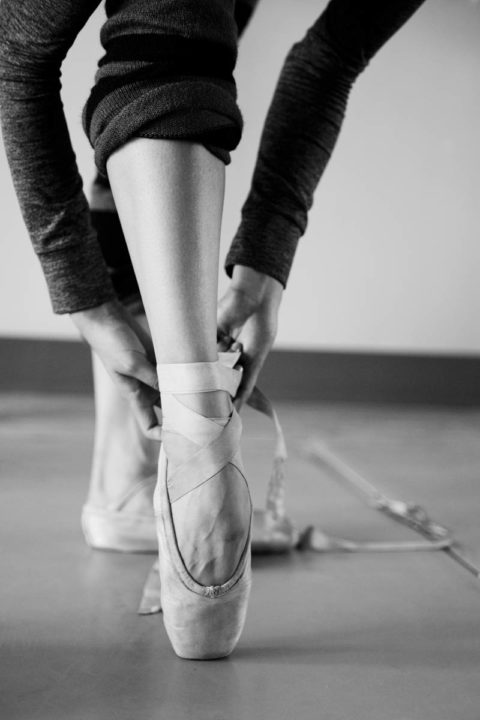Meet the dancers: All about The National Ballet of Canada’s newest additions
It’s a dewy summer day and the mix of nerves and excitement is palpable at the National Ballet of Canada’s rehearsal space along the waterfront in Toronto. Erika Delponte, Soo Ah Kang and Calley Skalnik are just a week into their new roles as members of the corps de ballet and are rehearsing for the North American premiere of Christopher Wheeldon’s The Winter’s Tale. Today, the trio are joined by the internationally renowned principal dancer Jurgita Dronina. The 29-year-old previously danced with the Royal Swedish Ballet and the Dutch National Ballet before making the move to Toronto just one week prior with her two-year-old son and her husband.
All of these women have spent much of their childhood and adolescence in different corners of the world, living at boarding schools and training all day with the hope of achieving professional dancer status. The new corps dancers beat out close to 300 other applicants to score their new roles. Dronina, who is already a star in ballet circles, simply reached out to the National Ballet’s artistic director, Karen Kain, to explore whether the company would be a good fit.
“I’ve been fortunate to work with fantastic people like Natalia Makarova and Patrice Bart,” Dronina says of the famed dancers/choreographers. The fact that great artists like Kain and Mikhail Baryshnikov have been associated with the National Ballet also had huge appeal. Dronina has danced the title roles in Giselle and Wheeldon’s Cinderella. But as an artist, she says she aspires to draw inspiration from her surroundings. Hence her decision to make the big move. “This company has strong artistic values,” she says. “It values individuality and it has a rich repertoire.”
Achieving critically acclaimed principal status is something most dancers can only dream of. Glamorous? Yes. But it comes with intense pressure. “When you’re a principal dancer and an international guest star you travel a lot—you always have to be on top. There are no bad days,” she says. “It takes a lot out of the body and mind. We’re top athletes; we work non-stop.” Before getting into art school and focusing on dance at 10 years old, “I was doing hip hop and gymnastics and playing football with the guys,” she says. “I grew up very quickly.”
Dedication and sacrifice are two things all professional dancers can relate to, regardless of their position within a company. It’s all part of chasing the dream. Twenty-one-year-old Kang, for example, left her family in South Korea six years ago to join Canada’s National Ballet School (NBS), where she grew up watching these dancers. “I can’t believe I’m in the same room working with them now,” she says.
Skalnik, also 21, shares Kang’s commitment. “All of my time was devoted to it; you don’t have time for anything else. It’s just school and ballet,” she says. Her journey toward turning professional began when she was spotted at a dance competition in New York City and was offered a scholarship to NBS. This is her second time trying out for the company; the first time she was told to train more and then come back. Waiting to hear the verdict was nerve-racking, she says.
For corps dancers, there’s the added pressure of trying to find their place within the company. “When you’re new anywhere, it’s about figuring out the dynamics, the protocol, the politics. You want to shine, but you don’t want to step on anyone’s toes,” explains Krista Dowson, a former National Ballet dancer who is now a costume designer, as the four women change into her designs for the shoot.
“My first day was OK. I felt confused, though, because there were so many new things to learn,” agrees 25-year-old Delponte. Originally from Italy, she most recently worked as a member of the corps de ballet at the Hong Kong Ballet. The physical part is difficult, no doubt, but Delponte says learning how to control and express feelings is even more challenging. “In school, you’re always taught to be in line, to be straight, to do your work.” In the corps, you’re working as one with synchronized movements. “But [conveying] emotions and feelings is a big part of a ballerina’s job.” The new members are also getting used to a gruelling schedule. “At school, we would have academics and then ballet class. The day was more split up so you didn’t get as tired or prone to injury,” says Skalnik. “Now we train from 10 a.m. to 6:30 p.m. with an hour break for lunch.”
“Stamina and strength are the hardest part for me,” says Kang. “You have to pursue this endless perfection that you can never really achieve.” But, like all of the women here today, she’s never thought about doing anything else.
Kang also tried out for the company once before. “When I got into the National Ballet, it made me realize that talent isn’t just about being born with it. It’s effort and time,” she says.
Having spent 14 years as a dancer with the company, Dowson says the camaraderie will always win over the newbies who make great strides. “You sweat and cry and bleed with these people and you really become a team.” And then one day you might be one of the lucky few who achieve the ultimate dream of becoming a prima ballerina. “It took me a lot to get to where I am and to maintain it. I’ve been working non-stop,” says Dronina. “But I love my life.”
The post Meet the dancers: All about The National Ballet of Canada’s newest additions appeared first on FASHION Magazine.



